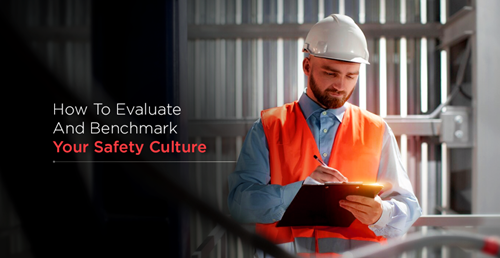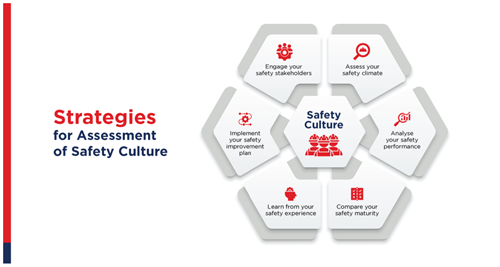How To Evaluate And Benchmark Your Safety Culture
Evaluating safety culture is crucial for organisations to ensure the well-being of employees and mitigate risks. By understanding how to evaluate safety culture, organisations can identify strengths, weaknesses, and areas for improvement in their safety practices and procedures.

This process enables them to proactively address safety concerns, implement corrective measures, and foster a culture of safety excellence. This blog will help you understand safety culture, explore safety culture strategies for assessment, and discuss the concepts of benchmarking and continuous improvement in safety culture.
Understanding Safety Culture
A strong safety culture prioritises safety as a fundamental aspect of operations, promoting awareness, accountability, and continuous improvement in safety practices. It involves fostering open communication, encouraging proactive hazard identification and mitigation, and empowering employees to take ownership of safety-related decisions and actions. Ultimately, safety culture influences how individuals perceive and respond to safety risks, shaping the overall safety performance and outcomes within the organisation.

Strategies for Safety Culture Assessment
Here are strategies that could be used to evaluate cultural safety at an organisation:
Assess Your Safety Climate: Begin by evaluating the current state of your safety climate through surveys, focus groups, and observation. This process provides insights into employees' perceptions of safety and identifies areas of concern.
Analyse Your Safety Performance: Conduct an OHS audit to assess compliance with safety regulations, identify hazards, and evaluate the effectiveness of existing safety protocols and procedures.
Compare Your Safety Maturity: Benchmark your safety performance against industry standards and best practices to gauge your organisation's maturity level and identify areas where improvements are needed.
Implement Your Safety Improvement Plan: Develop a comprehensive safety improvement plan based on the findings of your assessments, prioritising areas for enhancement and establishing measurable goals and timelines.
Engage Your Safety Stakeholders: Foster open communication and collaboration among employees, managers, and safety professionals to create a shared vision for safety and encourage active participation in safety initiatives.
Learn from Your Safety Experience: Continuously monitor and evaluate safety performance, learn from incidents and near-misses, and adapt your safety strategies accordingly to drive continuous improvement.
Benchmarking and Continuous Improvement
Benchmarking
Benchmarking involves comparing an organisation's safety performance, practices, and outcomes against industry standards, best practices, or peer organisations. By benchmarking their safety culture, organisations can gain valuable insights into areas for improvement and set realistic targets for improvement. Here are some key benefits of benchmarking:
- Identifying Best Practices: Benchmarking allows organisations to identify industry leaders and learn from their best practices in safety management.
- Setting Performance Targets: By comparing safety metrics against industry standards, organisations can set realistic performance targets and track their progress over time.
- Improving Competitiveness: By benchmarking against industry leaders, organisations can identify areas for improvement and enhance their competitiveness.
Continuous Improvement
In the context of safety culture, continuous improvement involves regularly reviewing safety practices, identifying areas for enhancement, and implementing corrective actions to drive positive change. Here are some key benefits of continuous improvement:
- Avoiding Future Incidents: By conducting thorough investigations and analysing root causes, corrective actions can be implemented to address underlying safety issues and prevent future incidents.
- Employee Engagement: By involving employees in safety initiatives, encouraging feedback, and empowering them to suggest improvements, organisations can harness their collective knowledge and expertise to drive improvement in safety culture.
- Implementing Safety Feedback Loops: By regularly soliciting feedback, evaluating the impact of interventions, and making necessary adjustments, organisations can ensure their safety culture remains dynamic and responsive.
- Leadership Commitment: By demonstrating a commitment to safety, providing resources, and actively participating in improvement efforts, leaders set the tone for a culture of continuous improvement and empower employees to prioritise safety in their work.
Conclusion
To conclude, fostering a step change in safety culture requires a proactive approach to evaluation, engagement, and improvement. By assessing current attitudes toward health and safety, organisations can identify areas of strength and weakness, develop targeted improvement plans, and engage stakeholders in driving meaningful change. Through ongoing assessment, benchmarking, and continuous improvement efforts, organisations can create safer, healthier workplaces where employees thrive and organisations prosper.
At British Safety Council, we firmly believe that maintaining a strong workplace safety culture requires collaborative efforts and forward-thinking leadership. That's why we offer our flagship product- 'Five Star Audits', designed to provide a thorough and quantified assessment of safety practices. Our suite includes internationally recognised audits such as the Five Star Environmental Sustainability Audit, Occupational Health and Safety Audit, and Process Safety Audit. By adopting a 'Critical Friend' approach, we work closely with your organisation to improve safety performance and enhance employee well-being.
